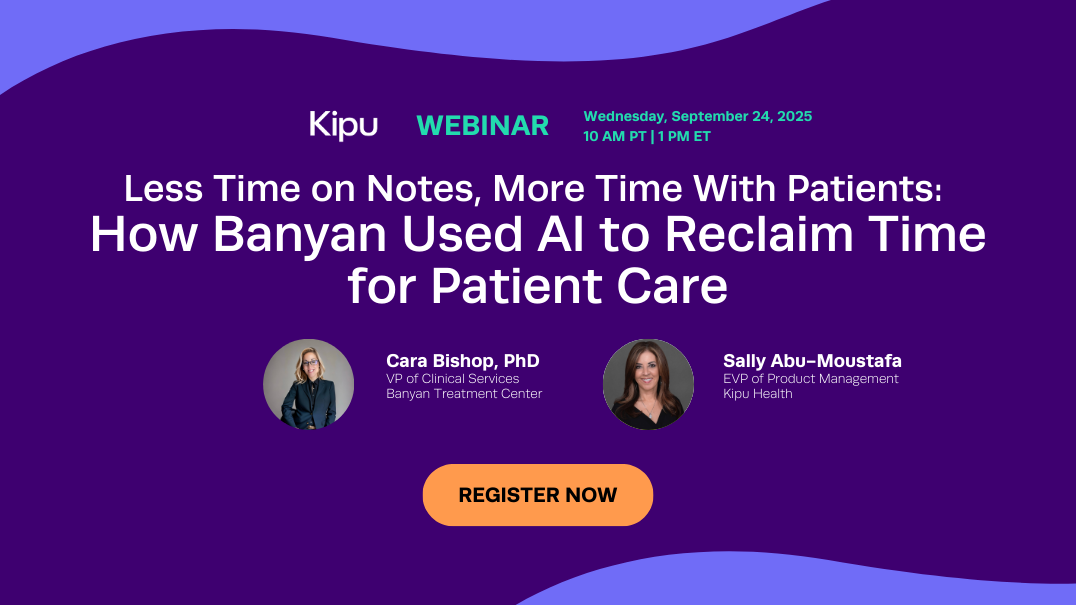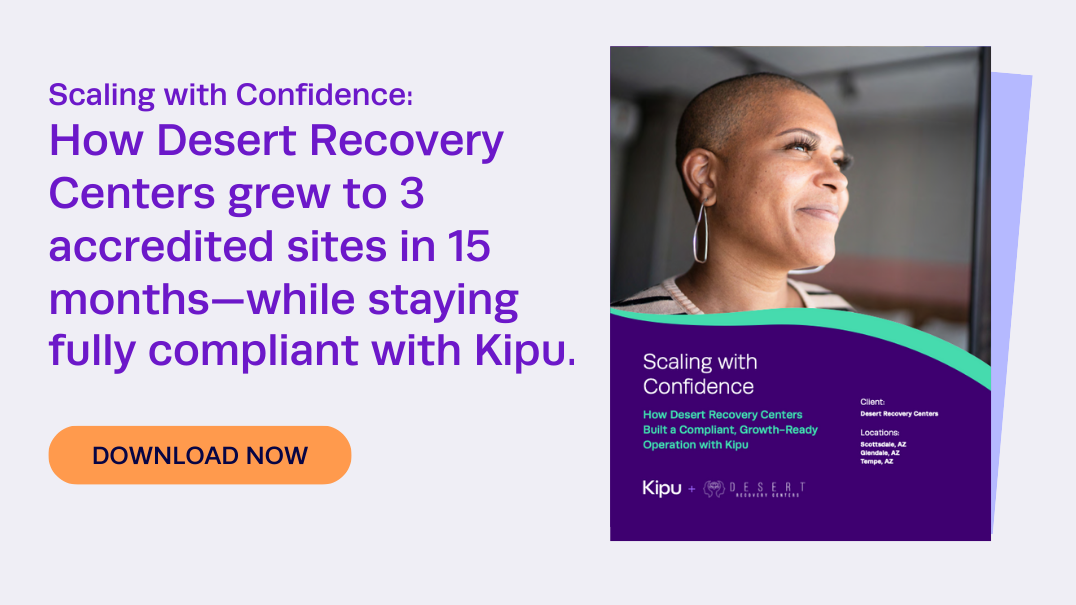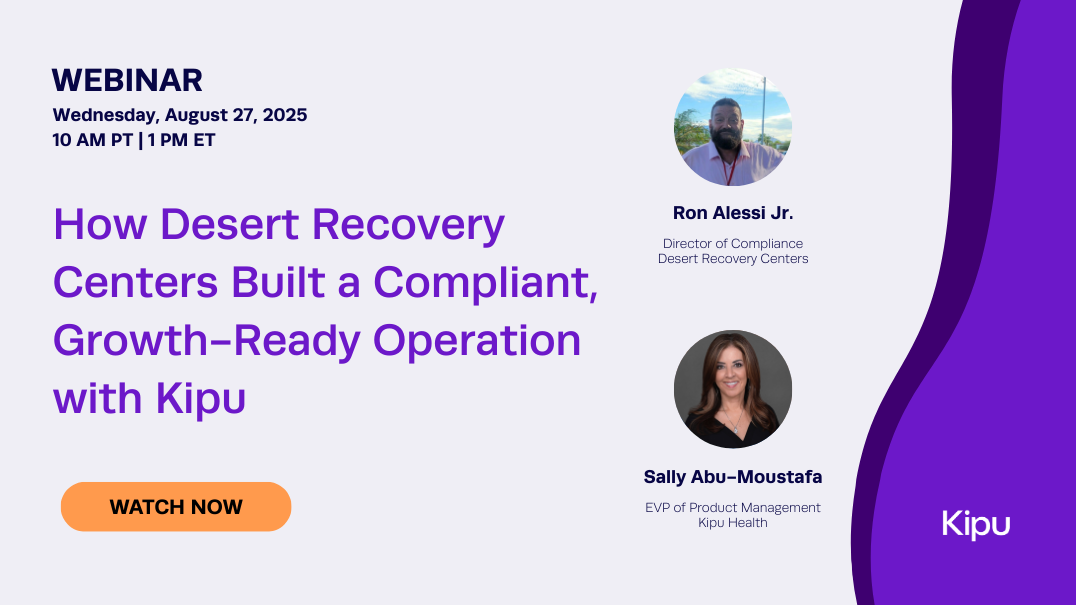Building Growth-Ready Operations: 5 Lessons Learned from Desert Recovery Centers

Running a behavioral health facility in today’s landscape can feel like building a house during an earthquake. The ground is constantly shifting with new regulations, workforce shortages, rising patient demand. How can you figure out how to balance compliance, efficiency, and growth without losing sight of your mission?
We recently hosted a webinar with Ron Alessi, the Operations Leader at Desert Recovery Centers (DRC) to hear about how they’ve navigated these issues. In just under two years, they’ve scaled from startup to multi-location, Joint Commission–accredited provider. Their secret? A relentless focus on operational excellence, powered by adaptable technology and a leadership team unwilling to compromise on compliance.
Here are the key lessons providers can take from their story.
1. Compliance Is the Foundation, Not an Afterthought
DRC learned early that compliant documentation isn’t just about passing an audit; it’s the key to sustainability. Every piece of documentation at DRC is reviewed three times: by the staff member who created it, by operations leadership, and by the clinical director. That level of rigor may sound excessive, but it’s paid off. When UnitedHealthcare audited the facility, DRC was able to adapt their forms and workflows in real time to meet payer requirements—and came out stronger for it.
As Ron summed it up, “If any one piece of documentation is out of place, that can be a reason for the insurance company not to pay. That hasn’t been our experience because we built a system of oversight into Kipu.”
The takeaway: Build compliance into everyday workflows, not as a scramble when an audit looms. Technology that allows on-the-fly customization of forms and real-time compliance checks can make this possible.
2. Choose (and Empower) a Super Admin
One of the strongest recommendations from Ron was clear: pick one person to be your “super admin.” This role is more than just a system operator—it’s someone who understands compliance, clinical workflows, and the bigger picture. At DRC, Ron uses Kipu to manage day-to-day documentation, be he also uses our software to proactively monitor quality, train staff, and ensure that documentation always tells the story of medical necessity.
As Ron explained, “When you have multiple super admins, it muddies the water. At DRC, I’m the only one—and everything I build flows down clearly to supervisors and then to staff.”
The takeaway: Don’t spread system oversight across too many people. Instead, designate a point person with the authority and vision to shape the system around your program—not the other way around.
3. Let Your EHR Work the Way You Work
Ron has used multiple EHRs across his career. His verdict? Most systems force providers to fit their workflows into rigid templates. Kipu, by contrast, allowed DRC to integrate the technology into their program, not vice versa. That adaptability proved essential during both payer audits and Joint Commission accreditation, where inspectors asked for specific language changes that could be made instantly within the system.
In Ron’s words: “With other EHRs, you’re limited. With Kipu, we have the ability to wrap the system around our program instead of the other way around.”
The takeaway: Look for platforms that adapt to your workflows instead of dictating them. The ability to customize forms, automate compliance checks, and integrate across teams reduces frustration and speeds growth.
4. Plan for Tomorrow, Not Just Today
As Kipu’s EVP of Product, Sally Abu-Mustafa, pointed out during the webinar, growth inevitably adds complexity. Providers that rely on patchwork solutions often end up with silos and inefficiencies. The better path is to invest early in tools that can scale—like AI-powered note assistants that cut documentation time by over 40%. For DRC, this forward-thinking mindset has freed clinicians to focus less on paperwork and more on patients.
Ron reinforced the point: “I’m able to adjust our workflows on the fly during an audit. That adaptability has set us up for long-term growth.”
The takeaway: Technology should evolve with you. Choose systems that offer automation, AI, and compliance tools built into the workflow so you’re not constantly retrofitting processes as you grow.
5. Documentation Is Advocacy
Perhaps the most striking message from the webinar was that documentation isn’t just paperwork, it’s advocacy. As Ron put it, “We in behavioral health are client advocates. The only way I’m going to advocate for the client is to do that through the documentation.”
He added, “At the end of the day, it’s about telling the client’s story clearly so payers see medical necessity and our team sees the full picture of care.”
By ensuring every note reflects the patient’s journey, DRC not only secures reimbursement but also strengthens continuity of care and demonstrates true medical necessity.
The takeaway: Reframe documentation for your staff. It’s not busywork; it’s a critical part of advocating for every patient who walks through the door.
Building a Growth-Ready Future
DRC’s story isn’t just about surviving audits or getting accredited, it’s about building a growth-ready operation without losing sight of mission. Their lessons are clear:
- Make compliance part of daily workflows.
- Designate a trusted super admin.
- Use technology that adapts to you.
- Invest early in scalable tools.
- Treat documentation as advocacy, not a burden.
In a field as complex as behavioral health, those lessons can make the difference between facilities that scramble to keep up and those that thrive.
If you missed it the webinar, you can find it on-demand here:
Want to see how Kipu can help your organization build resilience, scalability, and compliance into your operations?
Recent Posts
Rely on Kipu to keep you ahead of change.
Subscribe to Kipu for behavioral health news, updates, community celebration, and product announcements.


